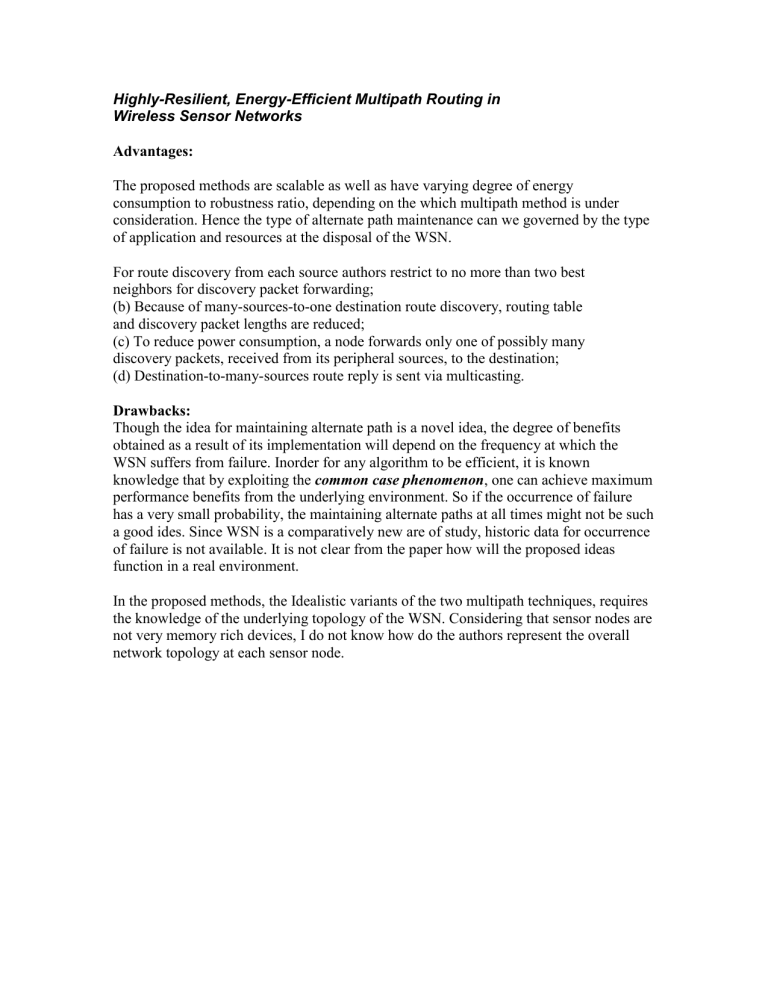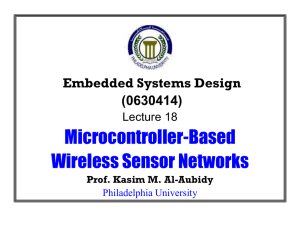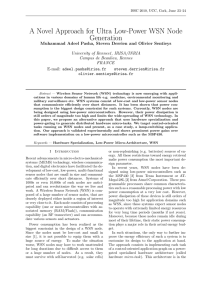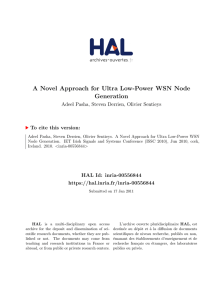Highly-Resilient, Energy-Efficient Multipath Routing in Wireless Sensor Networks

Highly-Resilient, Energy-Efficient Multipath Routing in
Wireless Sensor Networks
Advantages:
The proposed methods are scalable as well as have varying degree of energy consumption to robustness ratio, depending on the which multipath method is under consideration. Hence the type of alternate path maintenance can we governed by the type of application and resources at the disposal of the WSN.
For route discovery from each source authors restrict to no more than two best neighbors for discovery packet forwarding;
(b) Because of many-sources-to-one destination route discovery, routing table and discovery packet lengths are reduced;
(c) To reduce power consumption, a node forwards only one of possibly many discovery packets, received from its peripheral sources, to the destination;
(d) Destination-to-many-sources route reply is sent via multicasting.
Drawbacks:
Though the idea for maintaining alternate path is a novel idea, the degree of benefits obtained as a result of its implementation will depend on the frequency at which the
WSN suffers from failure. Inorder for any algorithm to be efficient, it is known knowledge that by exploiting the common case phenomenon , one can achieve maximum performance benefits from the underlying environment. So if the occurrence of failure has a very small probability, the maintaining alternate paths at all times might not be such a good ides. Since WSN is a comparatively new are of study, historic data for occurrence of failure is not available. It is not clear from the paper how will the proposed ideas function in a real environment.
In the proposed methods, the Idealistic variants of the two multipath techniques, requires the knowledge of the underlying topology of the WSN. Considering that sensor nodes are not very memory rich devices, I do not know how do the authors represent the overall network topology at each sensor node.
Meshed Multipath routing with selective forwarding: an efficient strategy in wireless sensor network
Advantages:
Since the M-MPR scheme proposed in the literature allows few intermediate nodes to have more than one forwarding direction to a given destination, the protocol is efficient and at the same time reliable. Hence successful end-to-end delivery of the information packet is ensured.
• The M-MPR SF variant takes its decision to forward packets dynamically, based on network conditions.
• End-to-End FEC coding is used to avoid acknowledgement-based retransmission.
• Mesh based multipath searching scheme requires lower control overhead and a smaller nodal database. Hence is very resource efficient.
• Since the entry in the routing table at a node is maintained as a soft state, it can be easily deleted after a threshold value timeout, unless it receives a reply from the controller node.
• If the discovery packets from many sensor nodes arrive at the controller node, the sensor node are replied back via a multicast-based reply, resulting in efficiency of resource which the primary goal in WSN.
• If an intermediate node goes out of service or enters sleep mode to conserve energy, the upstream nodes select appropriate neighbors inorder to remain connected.
• Link breakage due to interference is not considered a form of disconnection and will not trigger reconfiguration of the meshed multipath. Again this conserves power.
• Packet distribution policy automatically refreshes a nodes association with the mesh, hence minimizes the need for explicit route maintenance.
• Because of the used of broadcasting in M-MPR, there is no extra energy expended for transmission compared
• M-MPR is more flexible than D-MPR in making selective forwarding decision, hence increases the probability of successful packet delivery. a) Instead of splitting traffic along disjoint multipath, meshed route introduces more flexibility in on-the-fly routing decision;
(b) Instead of sending traffic along a preferential (primary) route among a number of disjoint or partially disjoint multiple alternatives, M-MPR distributes traffic evenly in the mesh, thereby achieving better load balancing and requiring lesser signaling overhead for multiple route maintenance;
(c) The absence of acknowledgment-based re-transmission and rerouting simplifies the flow control mechanism, and reduces energy and buffer requirements at the field sensors.
Drawbacks:
To minimize possible medium access conflict, M-MPR requires either a tunable receiver or greater number of fix-tuned receivers. This is a strain on the resource-poor sensors.
• The main problem according to me is that the proposed routing protocol assumes that the WSN it is deployed is a trusted environment and all the sensors in the WSN function
as expected. The authors have not mentioned how the protocol deals with so called
“ enemy modes
”
• Selective forwarding is known to be prone to attacks, where an enemy node does not forward the information packet in the expected manner.
• There is no provision in the protocol to deal with malicious sensor nodes that assume multiple identities and hence reduce the effectiveness of fault tolerance schemes.
• During the meshed multipath construction, when the sensor nodes commence understanding the network topology by way communicating and registering parameters of their respective neighbors, there is no way the proposed protocol can reframe an enemy from constructing legitimate traffic or rebroadcasting overhead packets.
The paper deals with one source and one destination together with the meshed multipath routes between them in detail, and then extends their proposal into many-to-one scenarios by multicasting the route reply from the destination to the multiple sources. They have not considered the redundancies of data originated from these multiple sources, which is usually true under high densely deployed sensor networks.
In addition, authors assume that an intermediate node can perfectly forward maximum two downstream neighbors under broadcast nature media via Direct Sequence Spread
Spectrum (DS-SS) based MAC where each node has its unique (orthogonal) code for transmission. However, the number of such codes is limited. We must consider some spatial separation dependent code reuse.
Finally, authors do not state their simulation environment expect simulation parameters, one can not repeat or verify their results via simulations.





